
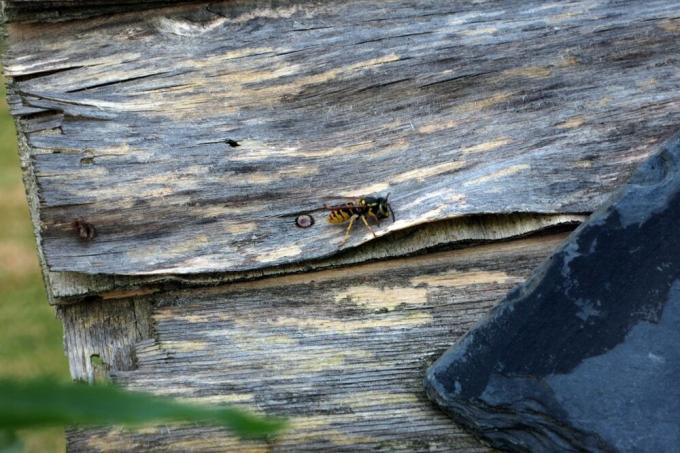
Table of contents
- wasp species
- way of life
- nest
- life cycle
- harm - benefit
- Damage
- To use
- roof tiles, attic
- facade, insulation
- roller shutter boxes
- distance
- normal case
- Emergency
- warning
- Precautions, Prevention
- Wood
- facades
- roller shutter boxes
- Commonality
- Legal
- Conclusion
Wasps also like to build their own home on or in people's homes. Can this lead to serious damage to the house or consequential damage to the building fabric? Is a peaceful coexistence of humans and wasps possible in this close proximity? If not, how do you get rid of them? Or preventively, what can you do to prevent them from settling in in the first place? Some basic knowledge about wasps, wasp nests, roofs and facades can help to act appropriately in individual cases.
wasp species
Around 4000 different species are assigned to the family of wasps (Vespidae). Here again there are two subfamilies, the solitary wasps and the true wasps.
The subfamily of real wasps is in turn divided into three groups: hornets, long-headed wasps and short-headed wasps. The long-headed wasp species are hardly a nuisance to us, as they don't seek to be close to humans so much. In addition, they are short-cycle and disappeared from the scene as early as the end of August. They mostly build free-hanging nests, in trees, shrubs and occasionally under an eaves. But this construction method is unproblematic for the building fabric. Usually these are the types:
- Mean wasp
- Saxon wasp
- wood wasp
- Norwegian wasp
The three species of wasps we deal with most often are: the German wasp (Short-headed wasp), the common wasp (Short-headed wasp), and the hornet.
way of life
Almost all real wasps form colonies, including the common and the German wasp. They build nests and have a queen. Their penchant for treating themselves to loads of sweets towards the end of summer makes them a nuisance to humans.
nest
These two species like to build their nests in secret and close to us. Popular nesting places are the compost heap, in the ground, under the roof or in facades or roller shutter boxes. Their states can consist of up to 7,000 individuals.
The material they use for this, the wasp paper, is made of wood. To do this, they mainly mix rotten or dry wood with their saliva, resulting in small balls. These are then built up into brood combs. The dried material is extremely hard and durable.
life cycle
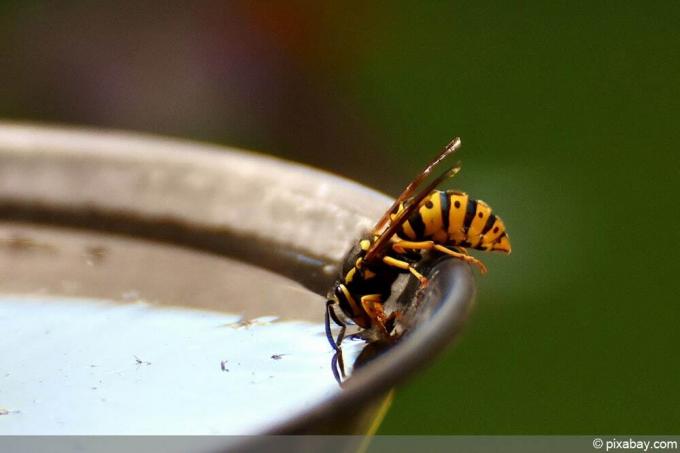
A wasp's life is very short. A young queen begins to establish her state in the spring:
- Queen builds a few combs
- lays eggs and nurtures them up
- the first workers hatch
- Workers now take over further nest building and feeding further larvae
- the larvae are fed exclusively with a pulp of insects
- The queen is then almost exclusively responsible for laying eggs
- the nest grows
- in late summer, drones hatch (males capable of fertilization)
- and young queens
- the drones die after mating
- the young queens hibernate under rotten wood
- the old queen dies in October/November along with her entourage
Every year a young queen builds a new nest. Old buildings are no longer used. However, old nests that still exist can persuade the queen to settle nearby by their smell.
harm - benefit
Before we get down to the (construction) substance when it comes to the wasp nest, a brief overview of the expected damage can and whether these pests (mainly: short-headed wasps, hornets) are not also useful in some way can. What happens when hornets, common and German wasps build their nests directly on, in or in the immediate vicinity of the house:
Damage
- Removal of material for access
- Gnawing material for nest building
- Nest can block blinds
- Aggressive behavior due to people being too close to the nest (< 2 to 3 meters)
- Discoloration, caustic, smelling droppings (in hornets)
To use
- eat pests, including aphids, tree pests and mosquitoes
- eat carrion, dead animals
- pollinate the native flowers
roof tiles, attic

Especially older houses and houses that are listed buildings offer attractive opportunities for searching queens to build their nest right here. The roof tiles are not final, they are mostly irregular because they are hand-made and thus allow the wasps to enter and shelter. It's dark and sheltered here.
Even the insulating material, if it is accessible and perhaps already porous, cannot stop a young queen willing to build from gnawing through it. After all, a dry, sheltered spot under the roof, on the attic or attic is tempting.
If a roof truss made of dry, untreated or even rotten wood is added, it seems this to become almost a paradise for nest building, after all the building material becomes the same included.
These circumstances already suggest that in most cases it is not the wasps themselves that cause the most damage here. They are more likely to use favorable opportunities or any existing vulnerabilities that present themselves to build their nest.
facade, insulation
Basically, the facade is the same as the roof. Every weak point is exploited by the young queen wasp in search of suitable building land. In most cases, the wasps only cause further damage here. Exactly when previous damage or negligent construction allows this.
It seems to be an invitation when the facade allows free access to the insulation layer. With their biting tools it is easy for the wasps to gnaw their way through until they find a suitable cavity. Serious damage occurs when a so-called cold bridge is caused by the feeding damage. The façade itself is therefore not particularly at risk, because wasps do not nibble through plaster, concrete, stone or similar hard substances.
Endangered areas in the facade are:
- Cracks in the outer facade
- Missing, damaged base rails, base profiles (end edges)
- insufficient connection of the concrete slabs to the thermal insulation composite system (ETICS)
- Inadequate reinforcement plaster (with fabric) at the connection, masonry and finishing plaster
roller shutter boxes
There is almost always a suitable access to dark, protected cavities here, which are perfect for a wasp nest. If the construction projects are not discovered early enough, sooner or later the functionality of these external blinds will suffer.
distance
Wasp nests that were built in facades or in the roof are usually only discovered when the population of the wasp colony and thus the nest have increased significantly. It's usually mid-August by then. Now is the time when the wasps get an appetite for sweets and become increasingly annoying. Before that, you often don't even notice them.
normal case
For this season, it's practically gone. You have to somehow arrange yourself with the wasps for the last warm days outdoors. There will no longer be any additional damage to the building structure.
An uninhabited nest can then be easily removed in winter. It is important to then completely remove the nest and then to thoroughly clean the area, for example with a water-vinegar mixture. Then this place offers no incentive for the young queen in the spring to build her nest again in this environment. Of course, all structural loopholes should then be repaired.
Tip:
Better yet, wait until early spring to remove the nest. Because in winter, the nests are still used by useful insects, such as the parasitic wasp, for hibernation.
Emergency
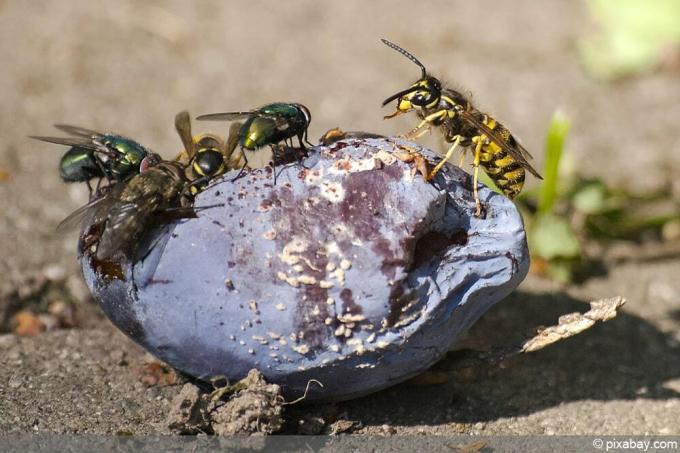
However, if you discover a nest and it becomes a threat to the family, you are faced with the question: How do we get rid of it as quickly as possible? Once again, if you discover a large, ready wasp nest, it will not be able to cause any further major damage to the house in the same year. The only question is: can we live with it until November, or is it impossible? For example due to:
- allergies in the family
- they have gained access to the interior from the roof
- Entry route to the nest runs across heavily used paths, entrances
In these cases, the best thing to do is to contact a competent specialist adviser in the municipality. The local fire brigade can either help or give appropriate advice.
warning
There are various reasons not to remove wasp nests yourself. Here are the most important:
- one should never radically kill any living beings
- Over-the-counter insecticides used to control wasps are not potentised enough to be effective
- fumigation is a very dangerous idea, especially in older homes
- Blocking entrances (gluing, filling): very bad for nests in the house, new passages are bitten through, possibly even into an interior space
- every unsuccessful attempt to destroy a wasp nest makes the animals doubly aggressive
- the Federal Nature Conservation Act (BNatSchG) prohibits the killing of wild animals without good reason
In an emergency, it is always better to seek professional advice. The responsibility can be found out from the fire brigade or the respective municipality.
Precautions, Prevention
The best way to protect your home and residents from structural damage and bites is prevention.
Wood
Wood is a material that wasps need to build their nests. Poorly cared for, rotten wood on the house is an invitation. In the meantime, there are also environmentally friendly paints and varnishes that can be used to work on wood, so that they are no longer an incentive for the wasps. Good care of wood cladding, roof truss and wood paneling should take place regularly, if only for the sake of the building fabric.
facades
When it comes to facades, cracks and missing edges are not to be taken lightly. Regular checks and, if necessary, repairs keep the house in good condition and also ensure that it remains unattractive for queens looking for a place to live.
Tip:
Attention, any free access to the insulating material between the facade and the wall is attractive for wasps looking for a new home.
roller shutter boxes
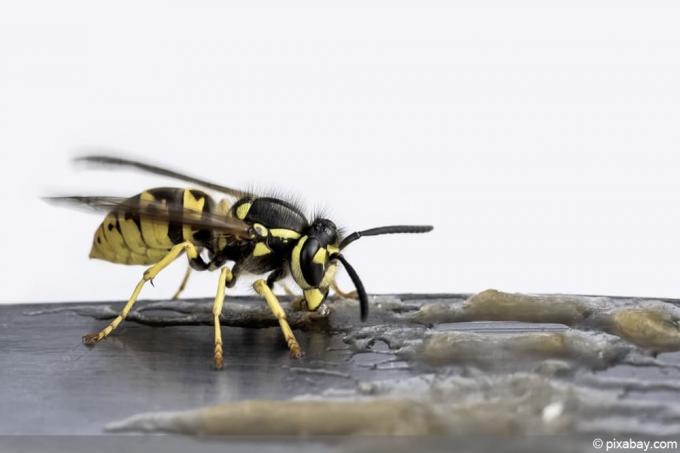
Here you can preventively keep the openings as small as possible and check them more often in the spring. True to the motto, resist the beginnings.
Actually, that's a good thing to watch. With a few lemon juice splashes you can then prevent the queen from settling down here. If it is already too late, do not try to get to the nest yourself or spray poison. In every municipality there are contact persons who can help with problems with wasp nests.
Commonality
If a wasp nest does not pose a threat to the house and residents, then it is best to let them do their thing. If you follow a few rules for peaceful coexistence, there will be no unwelcome incidents.
- don't get too close to the wasp's nest
- wasps around, no hectic movements
- Don't blow on wasps
- Remove fallen fruit regularly
- Be careful when eating and drinking outdoors
- If necessary, install fly screens in front of the windows
Legal
Two laws apply to protect wasps:
- according to § 39 para. 1 (...) of the Federal Nature Conservation Act (BNatSchG) it is forbidden to "kill wild animals without good reason". This law is of course a matter of interpretation, but it also offers basic protection for the quite common and annoying short-headed wasp.
- according to § 44 para. 1 (...) of the Federal Nature Conservation Act, it is forbidden to “wild animals of the specially protected To kill species.” In addition to this, species protection applies under the Federal Species Protection Ordinance (BArtSchV). The protected wasps include the hornet and three species of long-headed wasp (gyroscope, buttonhorn and Saxon wasp). But the middle wasp is also considered worthy of protection, although it is not mentioned by name.
As punishment, the law provides for fines of 50,000 euros and imprisonment for up to five years. These are also reasons enough never to attack a wasps' nest yourself. To make matters worse, not everyone can tell the difference between long-headed wasps and short-headed wasps. Even confusion with bee nests occur again and again.
Tip:
Homeowners with a wasp nest are not legally responsible for damage and nuisance caused by these (“their”) wasps to their neighbors.
Conclusion
It's the old game, man loves nature as long as he thinks he has it under control. Especially as long as it doesn't harm him or his property. With the wasps there is definitely the possibility of a peaceful coexistence. If homeowners notice damage to the house that is supposedly caused by a wasp nest, you have to be honest: Who was there first? The crack in the facade or the wasp's nest?
 Home editorial office
Home editorial office
Learn more about wasps & hornets

Remove the bee nest from the roller shutter box - this is how you get rid of it
If bees have converted a roller shutter box into a nest, there is no place for irrational panic. With prudence and these instructions, you can solve the problem without harming people or bees. Learn how to get rid of the bee nest here.

Does coffee grounds help against clover in the lawn?
Clover in the lawn is a nuisance that many garden owners struggle with. Lawns, which in some cases are interspersed with numerous nests, are often affected. As an alternative to chemical agents, many wonder whether coffee grounds are effective against weeds.
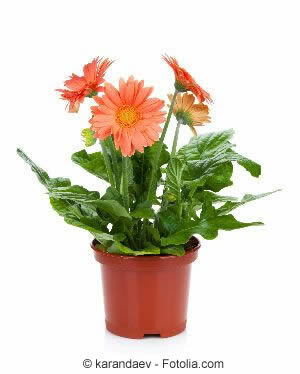
Pot gerbera - instructions for caring for gerberas in pots
The pot gerbera is a lot of fun, but requires a lot of care. It needs to be watered daily and fertilized regularly. A lot of light is a must and yet it must not be exposed to excessive heat. But if you treat her properly, she will thank you with her beautiful flowers.
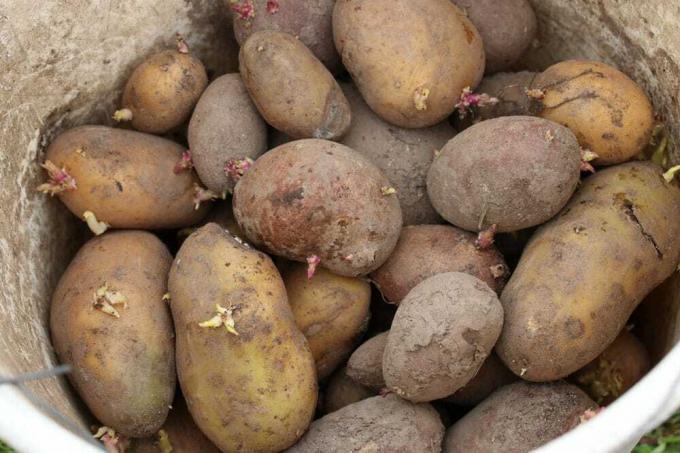
Harvest and store potatoes correctly - in the refrigerator, apartment & cellar
Important criteria for harvesting and storage must be observed so that delicious potatoes from your own cultivation are on the table from summer until next spring. These instructions explain in a practical way when and how to harvest potatoes correctly and store them perfectly. The advantages and disadvantages of refrigerators, apartments and basements as storage areas are examined in detail.

Hackberry, nettle tree, Celtis - types, plants and care
Hackberry trees are also known as nettle trees or botanically Celitis and belong to the hemp family. It is interesting that you can also harvest edible, cherry-like fruits for further processing from your own hackberry tree.

Catchfly, Silene viscaria - sowing, planting & care
The pitcher (Lychnis viscaria) is a perennial, bushy wild perennial belonging to the Carophyllaceae family. Since it originally comes from the Mediterranean region, it is suitable for moor gardens, for green roofs, as a hardy garden perennial and as a decorative cut flower. The plant usually flowers from May to August in a strong fire or chimney red and reaches a height of about 40 to 50 cm.
